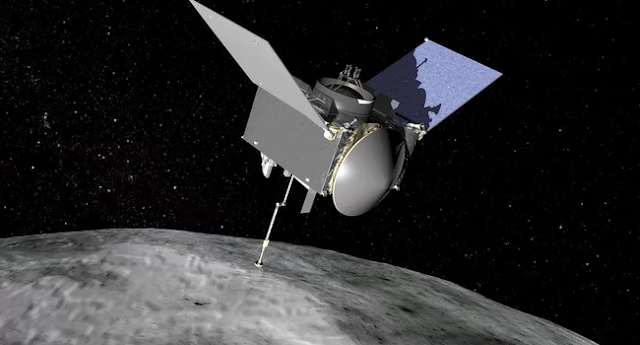NASA's OSIRIS-REx Probe, Its First Asteroid Sample Collector, Reaches Target 'Bennu'
NASA's first-ever mission designed to visit an asteroid and restore a sample of its dust back to Earth arrived Monday at its destination, Bennu, two years in the wake of propelling from Cape Canaveral, Florida.
The $800 million unmanned mission, known as OSIRIS-REx, made a rendezvous with the asteroid at around 12:10 pm (1710 GMT), terminating its engines the last time.
"We have arrived," said Javier Cerna, a designer at Lockheed Martin, as his colleagues at mission control in Littleton, Colorado cheered and traded high-fives, as indicated by a live NASA television broadcast.
Bennu is around 1,600 feet (500 meters) in distance across, about the size of a small mountain. It is the smallest protest ever to be circled by a human-made spacecraft.
A section of the early solar system, Bennu is also considered conceivably dangerous. It poses a slight risk - a one out of 2,700 shot - of crashing into Earth in 2135.
The carbon-rich asteroid was chosen from some 500,000 asteroids in the solar system because it orbits close to Earth's way around the Sun, is the correct size for the scientific study, and is one of the oldest asteroids known to NASA.
Scientists trust it will uncover more about the early development of the solar system, as well as how to discover precious resources like metals and water in asteroids.
"With asteroids, you have a period capsule. You have a pristine sample of what the solar system resembled billions of years back," said Michelle Thaller, a spokeswoman for NASA's Goddard Space Flight Center.
"That is the reason for scientists this sample will be unmistakably more precious than even gold."
Delicate high-five
The mission propelled in September 2016. In the course of recent months, OSIRIS REx has been crawling toward Bennu, lastly achieved the space shake when it was around 80 million miles (129 million kilometers) from Earth.
"For the past several months, Bennu has been coming into focus as I drew closer," said NASA's OSIRIS-REx Twitter account.
"Now that I'm here, I'll fly around the asteroid and study it in detail."
The spacecraft is furnished with a suite of five science instruments to study the asteroid for the following eighteen months, mapping it in high resolution to enable scientists to choose precisely where to sample from.
At that point, in 2020, it will connect with its automated arm and contact the asteroid in a move Rich Kuhns, OSIRIS-REx program administrator with Lockheed Martin Space Systems in Denver, described as a "delicate high-five."
Using a round gadget much like a vehicle's air channel, and a reverse vacuum to stir up and gather dust, the gadget aims to snatch around two ounces (60 grams) of material from the asteroid's surface and return it to Earth for further study.
NASA says it might get considerably more material, perhaps up to four pounds (two kilograms).
The US space office hopes to use OSIRIS-REx to bring back the largest payload of space samples since the Apollo time of the 1970s when American explorers gathered and conveyed back to Earth 842 pounds (382 kilograms) of Moon rocks.
Japanese space office JAXA first demonstrated sample gathering from an asteroid was possible.
JAXA's Hayabusa spacecraft crash-arrived into the surface of its target asteroid and figured out how to restore a couple of micrograms of material in 2010.
When the NASA mission has successfully gathered its space dust from Bennu, the sample will be kept in a canister and came back to Earth in 2023, contacting down in the Utah desert in late September, NASA said.
OSIRIS-REx stands for Origins, Spectral Interpretation, Resource Identification, Security-Regolith Explorer.a




0 Reviews:
Post a Comment